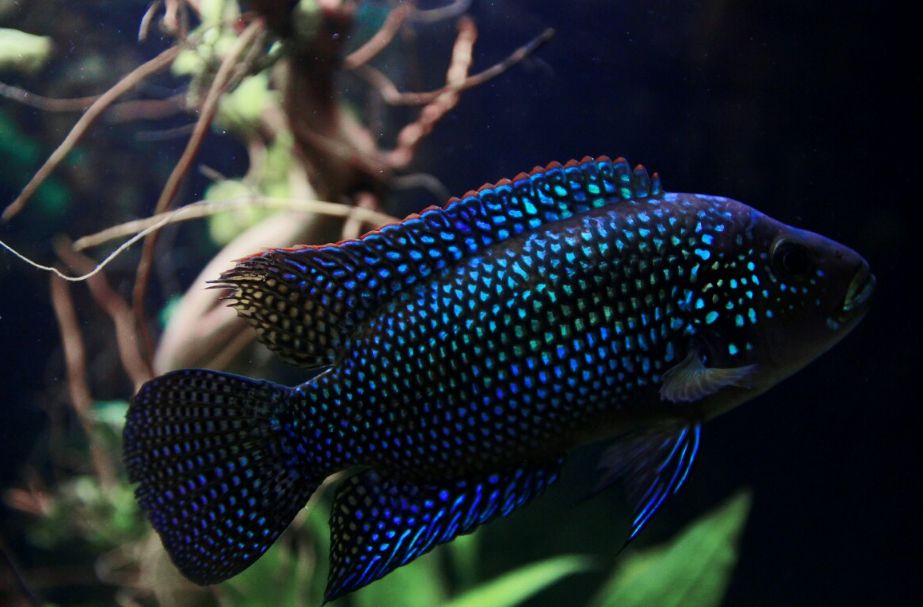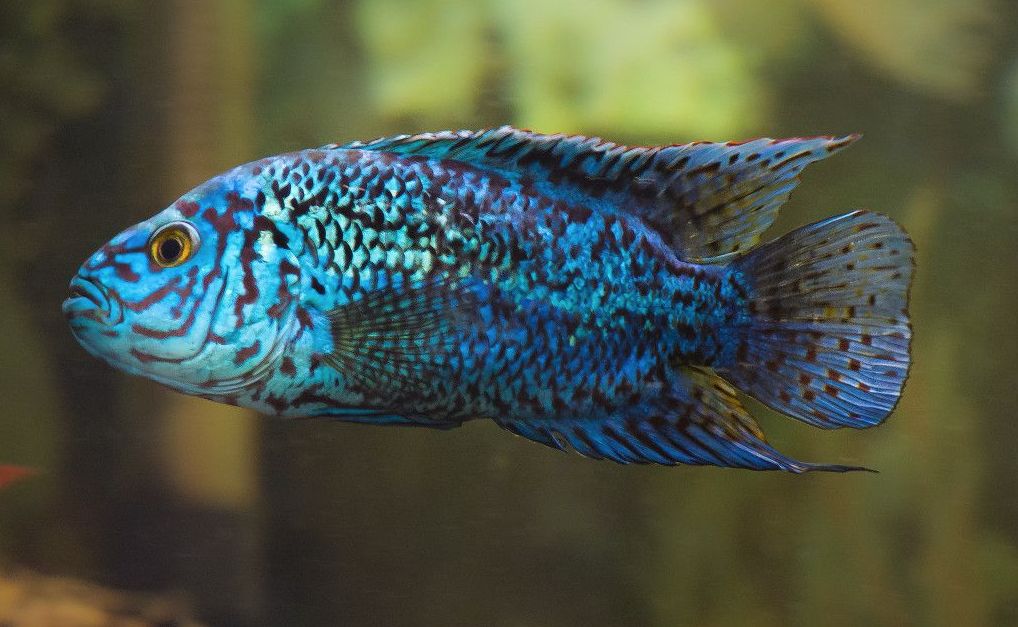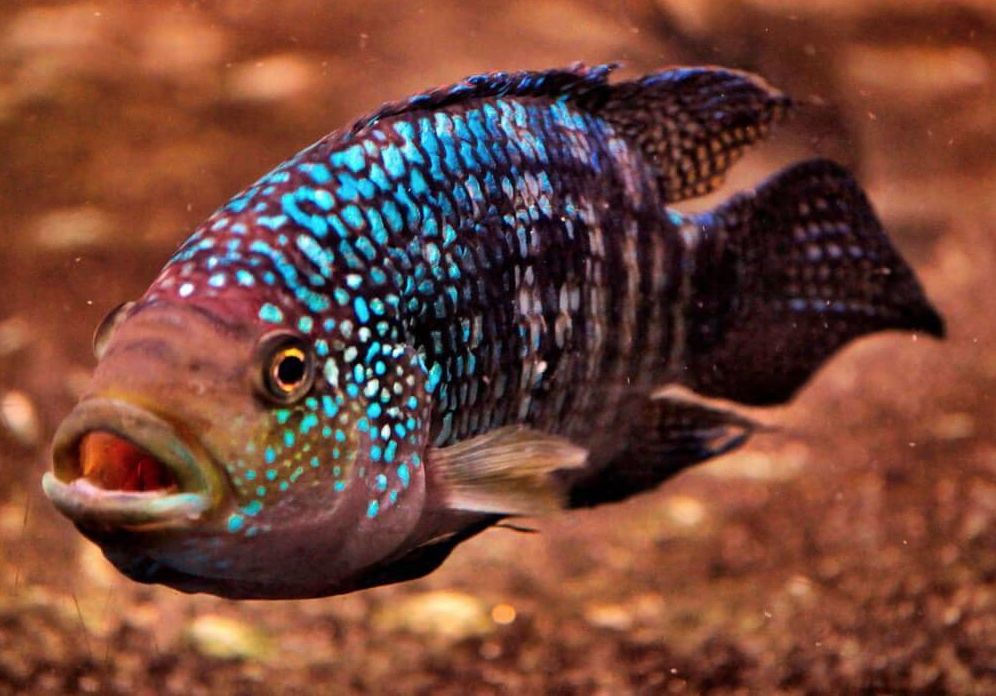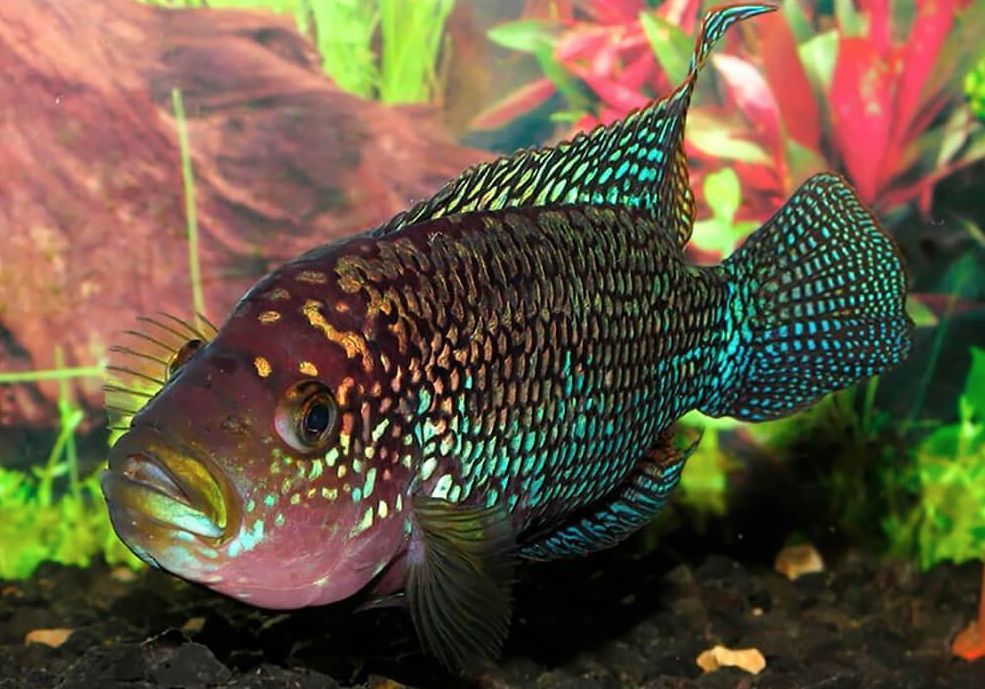The Jack Dempsey fish, native to North and Central America, is known for its aggressive temperament, which has earned it the name Jack Dempsey, after the famous boxer. This species displays particularly territorial behavior, especially during breeding, making it a challenging but rewarding choice for experienced aquarists. Despite its aggressive nature, the Jack Dempsey fish remains popular due to its striking coloration and robust health, making it a standout addition to larger, carefully managed aquariums.

Contents
Habitat in the wild
The Jack Dempsey fish, also known as Rocio octofasciata, is a popular freshwater species from the cichlid family, renowned for its vivid coloration and territorial behavior. Though cichlids are found worldwide, the Jack Dempsey is native to Central America, inhabiting rivers and lakes from Honduras to southern Mexico. It has also been introduced into regions of the southern United States, such as Florida, and even into waters in Thailand.
Originally described in 1903 as Heros octofasciatus, the species underwent several taxonomic revisions. A scientific mix-up initially suggested a wide distribution, including Brazil, but further research limited its native range to Central America. Mexican ichthyologist Juan Schmitter-Soto resolved this confusion in 2007 by classifying the species under a new genus, Rocio, which was named in honor of his wife. The species name “octofasciata” refers to the fish’s characteristic striped pattern, though the number of stripes often exceeds eight.
Jack Dempsey fish are typically found in shallow rivers with clear water, small spring-fed lakes, and slow-moving channels. They adapt to a variety of environments, including muddy or sandy bottoms, and are often seen in plant-filled watercourses. In captivity, their striking appearance and robust health make them a favorite among experienced aquarists, although their aggressive nature requires careful tank management.
Description
The body of the Jack Dempsey fish is primarily olive-drab, but during periods of aggression or spawning, its color deepens dramatically, sometimes turning almost black. Each scale, along with the opercles and fins, is adorned with shimmering spots that change in hue depending on the lighting and the fish’s mood, appearing blue, cyan, or golden.
Females are less vibrantly colored than males, with more subdued hues. Juveniles display more pronounced stripes, usually ten or eleven, though they tend to be faint. As the fish matures, these stripes fade, leaving only traces on the forehead, back, and abdomen. In adult males with richer coloring, the stripes are often visible only on the forehead.
Jack Dempsey fish also feature eyespots along the sides of their bodies and on the tail. These spots are more prominent in juveniles and fade as the fish ages. The iris is gray with a bronze tint, and the dorsal fin is edged with red, adding a striking contrast to its overall appearance.
Electric blue Jack Dempsey
In addition to the standard Jack Dempsey, there is a captivating variant known as the Electric Blue Jack Dempsey (EBJD). This fish is admired for its brilliant electric blue coloration, which sets it apart from the typical earthy tones of the original species, making it a popular choice among aquarium hobbyists.
There is ongoing debate regarding the origins of the Electric Blue Jack Dempsey. Some aquarists speculate that it may have emerged through crossbreeding with other cichlid species, similar to how the flowerhorn was developed. However, a more widely accepted explanation is that this vibrant blue coloration is the result of a genetic mutation. Such mutations are rare, and breeding high-quality EBJD specimens requires expert knowledge of genetics and selective breeding practices.
This rarity, along with the fish’s stunning appearance, makes the Electric Blue Jack Dempsey highly sought after in the aquarium trade. However, obtaining these fish can be challenging due to the specialized breeding required to produce them. As a result, the Electric Blue Jack Dempsey remains one of the most impressive and desirable variants within the cichlid family.

Are Jack Dempsey fish aggressive?
Jack Dempsey fish are well-known for their aggressive and territorial behavior, especially during breeding or when they feel their space is being encroached upon. Managing their aggression effectively is key to maintaining a peaceful aquarium environment. Here are several strategies to minimize aggression:
- Provide ample space and hiding spots: A spacious tank with plenty of natural barriers—such as caves, rocks, and driftwood—can help reduce territorial disputes. Hiding spots allow more timid fish to escape from potential confrontations, lowering overall stress levels.
- Select appropriate tank mates: When choosing tank mates, opt for species that can tolerate the Jack Dempsey’s temperament. Robust, semi-aggressive fish that can defend themselves, such as convicts or firemouth cichlids, are generally better suited than peaceful or slow-moving species.
- Avoid overcrowding: Adequate tank space is critical. Overcrowded environments lead to higher levels of stress and more frequent territorial disputes. Ensure that the aquarium is large enough to accommodate the Jack Dempsey and its tank mates, reducing the likelihood of aggressive encounters.
- Maintain optimal water quality: Poor water conditions can amplify stress and aggression in fish. Regular water changes and efficient filtration are essential to keep ammonia and nitrite levels low, ensuring the fish remain healthy and calm.
- Monitor behavior and be ready to separate: Regular observation is key. If any fish becomes excessively aggressive or begins harming others, consider removing or isolating the aggressive individual. This can prevent injury and restore balance in the tank.
By creating a well-structured environment with the right tank mates and conditions, you can successfully manage the natural aggression of Jack Dempsey fish while maintaining a harmonious aquarium.
Size
The Jack Dempsey is a medium-sized cichlid species. In captivity, males can grow up to 21 cm (8.27 inches), while females reach about 17 cm (6.69 inches). In the wild, however, males typically grow only to about 12-15 cm (4.72-5.91 inches). This difference in size is largely due to the more controlled environment in aquariums, where factors like diet, water quality, and tank size can significantly influence growth.
Genetics also play a role in determining the final size of individual fish, and providing optimal care—including a balanced diet and clean water—can help ensure your Jack Dempsey reaches its full potential in an aquarium setting.
Lifespan
With proper care and a suitable environment, Jack Dempsey fish typically live for about 8 to 10 years. However, their lifespan can vary based on factors such as genetics, water quality, diet, and overall living conditions.
| Characteristic | Description |
|---|---|
| Scientific Name | Rocio octofasciata |
| Common Name | Jack Dempsey fish |
| Family | Cichlidae |
| Origin | Central America (Mexico, Honduras, Guatemala, Belize) |
| Habitat | Freshwater rivers and streams |
| Size | Up to 10-15 inches (25-38 cm) |
| Lifespan | 8-10 years (with proper care) |
| Temperament | Can be territorial and aggressive |
| Color | Metallic blue-green body with iridescent scales |
| Markings | Vibrant spots and stripes |
| Diet | Omnivorous (eats both plant matter and small animals) |
| Tank Size | Minimum 55-gallon tank for one adult fish |
| Tank Setup | Plenty of hiding places, caves, and open swimming space |
| Water Parameters | pH: 6.5-7.5, Temperature: 72-86°F (22-30°C) |
| Compatibility | Can be aggressive towards other fish, especially during breeding |
| Breeding | Egg-layers, both parents care for the fry |
| Special Considerations | Requires regular maintenance and water quality checks |
Difficulties in keeping
Jack Dempsey fish are relatively easy to care for, making them suitable for beginners. However, it’s important to recognize their aggressive nature. While they may coexist peacefully with other cichlid species when young, their aggression tends to increase as they mature.
As they grow, it’s advisable to keep Jack Dempsey fish either alone or with larger, more robust fish that can withstand their territorial behavior. Understanding this aspect of their personality is crucial for maintaining a harmonious aquarium environment.

Care and keeping in a tank
Like many Central American cichlids, Jack Dempsey fish do not have overly complex requirements for tank conditions. However, it’s essential to maintain clean water, with zero ammonia and nitrite levels and nitrate concentrations below 40 mg/l. Strong biofiltration and regular water changes can help achieve these standards.
While this species can tolerate poor water conditions, leading some owners to overlook care, such resilience is misleading. Young fish may survive in water contaminated with nitrogen compounds, but many do not live beyond four years due to the cumulative effects of toxins. This neglect can lead to health issues, such as hexamitiasis and other diseases.
Tank size
The tank size for Jack Dempsey fish is influenced by various factors, including the number of fish you plan to keep and their size. Jack Dempsey fish can grow up to 10 inches (25 centimeters) in length and are known for their territorial and somewhat aggressive behavior, especially during breeding or when they feel threatened.
For a single adult Jack Dempsey, a minimum tank size of 55 gallons (about 208 liters) is recommended. This space allows the fish to swim freely, establish territories, and reduce aggression toward tank mates. If you intend to keep more than one Jack Dempsey in the same tank, a larger capacity is necessary to accommodate their territorial nature.
For a pair of adult Jack Dempseys, a tank size starting from 400 liters (104 gallons) is ideal. Aggression can significantly increase in smaller tanks (up to 250 liters or 66 gallons), where a breeding pair typically cannot tolerate any tank mates, unless they are compatible species like certain catfish or very small fish.
In smaller tanks, conflicts may arise between the male and female Jack Dempseys. If this occurs, it is advisable to remove the female from the tank. Keeping the pair together for 3 to 6 months, followed by a separation of 1.5 to 3 months, can help manage aggression in smaller setups. In larger tanks, the female can simply swim to the opposite side, minimizing stress.
Isolating the fish can also help reduce spawning frequency, which is important for their health, particularly for females, as frequent spawning can lead to health issues.
Larger tanks with ample space and hiding spots can help minimize stress and aggression among Jack Dempsey fish. Proper tank setup, water quality, and suitable tank mates are crucial for their overall well-being and health in a home aquarium.
Water parameters
Native to Central America, these cichlids thrive in specific water conditions that closely mimic their natural habitats. Here are the recommended water parameters for Jack Dempsey fish:
Temperature: The ideal temperature range is between 72 to 86°F (22 to 30°C). Keeping the water within this range ensures a comfortable environment that supports their health. When temperatures drop below 75°F (24°C), Jack Dempseys tend to stay close to the heater. Therefore, maintaining a temperature around 78.8 to 80.6°F (26–27°C) is optimal.
pH Level: Jack Dempseys prefer slightly acidic to neutral water conditions, with a recommended pH range of 6.5 to 7.5. It’s crucial to avoid significant fluctuations in pH levels, as stability is essential for their well-being.
Water Hardness: These fish can tolerate moderate water hardness, with an ideal range of 8 to 12 dH. This range helps replicate their natural environment.
Ammonia, Nitrite, and Nitrate Levels: Regularly testing for ammonia, nitrite, and nitrate levels is essential. Ammonia and nitrite should be maintained at 0 ppm, as both are toxic to fish. Nitrate levels should remain below 20-40 ppm, as high concentrations can be harmful over time.
Filtration and Water Quality: High-quality filtration is crucial for maintaining good water quality. Regular water changes of about 20-25% of the tank volume every 1-2 weeks will help keep the water clean and stable.
Tank setup: decorations and plants
When preparing a tank for Jack Dempsey fish, it’s essential to include various shelters to create a comfortable environment. These fish prefer subdued lighting and tend to be more active during dim conditions.
However, it’s important to be aware that Jack Dempsey fish can exhibit destructive behavior toward tank plants. While they typically do not eat plants, they may damage or uproot them if they decide they don’t belong in their territory.
To enhance your aquarium, consider using sturdy decorations and providing plenty of hiding spots. If you choose to include live plants, opt for more robust varieties, as these are less likely to be harmed. By creating a balanced and engaging environment, you can support the well-being of your Jack Dempsey fish while minimizing potential issues with decor and plants.
Diet
Jack Dempsey fish are natural ambush predators. In the wild, their diet primarily consists of small fish and various invertebrates. To replicate this diet in your aquarium, it’s essential to provide a mix of live, frozen, and high-quality prepared foods.
A suitable diet for Jack Dempsey fish includes:
High-Quality Pellets: Sinking pellets specifically designed for cichlids should form the foundation of their diet. Choose pellets that offer a balanced blend of proteins, fats, and essential nutrients to support their health.
Live Foods: These fish thrive on live foods, which can be excellent for stimulating natural hunting behaviors. Occasionally offer brine shrimp, bloodworms, daphnia, or small insects, especially during breeding periods.
Frozen Foods: As a convenient alternative to live foods, frozen brine shrimp, bloodworms, and other offerings from pet stores can be included. Always thaw them before feeding.
Flake Foods: While high-quality flake foods for cichlids can be part of their diet, pellets are generally preferred due to their sinking nature, which reduces waste.
Vegetables: Though primarily carnivorous, Jack Dempsey fish can benefit from occasional plant matter. Blanched or boiled vegetables like spinach, zucchini, and peas can be a nutritious treat.
Freeze-Dried Foods: Offering freeze-dried options, such as krill or worms, can add variety to their diet.
When feeding Jack Dempsey fish, avoid overfeeding, as this can lead to health issues and poor water quality. Offer small amounts several times a day and monitor their behavior to assess their appetite. Any uneaten food should be promptly removed to maintain optimal water conditions.
Variety is key to a well-rounded diet, so aim to provide a mix of these foods.

Gender differences: male vs female
In distinguishing between male and female Jack Dempsey fish, several key differences can be observed:
Size and Body Shape: Males are typically larger, more robust, and brightly colored than females. Adult males exhibit vibrant sparklet patterns covering most of their bodies, while females are generally less colorful.
Genital Papilla Shape: The male’s genital papilla resembles a hammer, while the female’s is shaped like an upside-down, blunted cone. This characteristic can be used to help identify the fish once they are mature.
Cyan Spots: Another distinction, though not always reliable, is that females often have cyan spots on the underside of their opercles, which males lack.
Juvenile Size: When purchasing juveniles, note that females can sometimes be larger than males at around 3-4 months old. Therefore, size alone isn’t a reliable indicator of gender at this stage.
Behavioral Indicators: Observing the fish can provide valuable clues. Males often display territorial behavior early on, guarding their space and attempting to exclude other juveniles. When agitated, males may exhibit darker coloring compared to females.
Dorsal Fin Shape: In juvenile fish, males have pointed dorsal fins, while females have rounded ones. However, as they mature, both genders can develop pointed dorsal fins, so this characteristic may not be as reliable later on.
By paying attention to these physical and behavioral traits, you can successfully identify the gender of Jack Dempsey fish, even at a young age. This knowledge is particularly useful when planning breeding or tank arrangements.
Tank mates
In spacious tanks, Jack Dempsey fish doesn’t show such aggression, as they may do in small capacity tanks. Therefore you can keep the fish together with other equal-sized cichlid species. In small tanks, fights between opposite-sex representatives are highly possible. At that, often, this is the female who initiates the fight despite its obvious loss in size group. If the male doesn’t take the challenge seriously, the more movable female can make a good trashing on him. If it comes to a real fight, the female gets injured badly. The only option to keep her alive is to put her into another tank.
It is possible to keep the fish harem – one male and several females. In this case, he can pay attention to each female in turns. When growing males together without females, later the males don’t show any aggression towards each other. However, exceptions are possible since, to a large extent, it depends on each fish’s temper.
In spacious tanks, the fish is less aggressive than in small ones, and it becomes possible to keep them together with other cichlids of equal size. These may be texas cichlid, salvin’s cichlid, red terror cichlid, oscar fish, jaguar cichlid, firemouth cichlid, convict cichlid.
However, experience has proven that it’s not a good idea. Since the presence of other cichlid kinds dampens natural fish behavior. The only exception is when all of them were raised together from the very beginning.
You shouldn’t keep Jack Dempsey fish with any small fishes (like guppies, platy, tiger barb, and harlequin rasboras) since they’ll be eventually eaten.
Breeding
Jack Dempsey fish reach reproductive maturity at about 12 months in the wild, but those kept in aquariums can spawn as early as 6 months.
Pair Formation: When keeping juvenile Jack Dempseys together, they often form pairs naturally. If you want to create a breeding pair, allow the male to choose from several females, as this reduces conflict and leads to a more stable pairing. If a dominant female shows aggression towards others, it’s best to remove her from the tank.
Spawning Environment: Jack Dempsey fish typically spawn on flat surfaces, such as large stones, flower pots, or cleared areas of the tank bottom. They may also dig pits to lay their eggs. Due to their digging behavior, it’s advisable to set up a separate spawning tank. If you have other fish, such as a sailfin pleco, consider removing them temporarily, as they may eat the eggs or cause conflicts.
Parental Care: Jack Dempseys are known for their attentive parenting. They do not require special interventions like aeration or removing unhealthy eggs. It’s essential to minimize disturbances during this time.
Egg Incubation: The eggs will hatch in about 3-6 days, depending on environmental conditions. Before hatching, the parents will move the eggs into pits they’ve dug. Don’t be alarmed if you see multiple pits; they may relocate the eggs several times throughout the day.
Feeding Fry: The larvae will begin feeding independently about four days after hatching. Suitable first foods include brine shrimp nauplii or specialized fry food.
Division of Responsibilities: In caring for their young, the female takes charge of the eggs and juveniles, while the male focuses on guarding their territory. This division can lead to conflicts, particularly if the female feels the male is not guarding adequately or is overly aggressive in protecting the fry.
To reduce stress and potential fights, it’s best to separate the male after spawning or once the juveniles begin swimming. If there are no other fish in the spawning tank, additional protection may not be necessary.